Featured Comment:
“A big thank you, Yuto, for this new salmon recipe, which looks (almost ) just as delicious as it is original. I truly appreciate the care you put into sharing your culinary creations. A wonderful discovery that I can’t wait to make again and enjoy once more!”
– Jean-Marie
What is Ponzu Salmon?
Ponzu salmon is a simple dish made with buttery pan-fried salmon fillets coated in a citrus-based Japanese ponzu glaze. You could say that this recipe is like teriyaki salmon meets sweet and sour, if you’re a fan of either of these dishes then you’re gonna love this!
Ponzu salmon is not a traditional Japanese dish, but it’s versatile and goes with pretty much anything. In Japan, it would be considered a great option for lunch with rice and miso soup or even served in a bento box.
I gave my ponzu salmon a bit of Western flare by serving it on one plate with mixed grain rice, baby leaf salad, and sautéed bell peppers and mushrooms, but you could also serve it with roasted vegetables or salad!
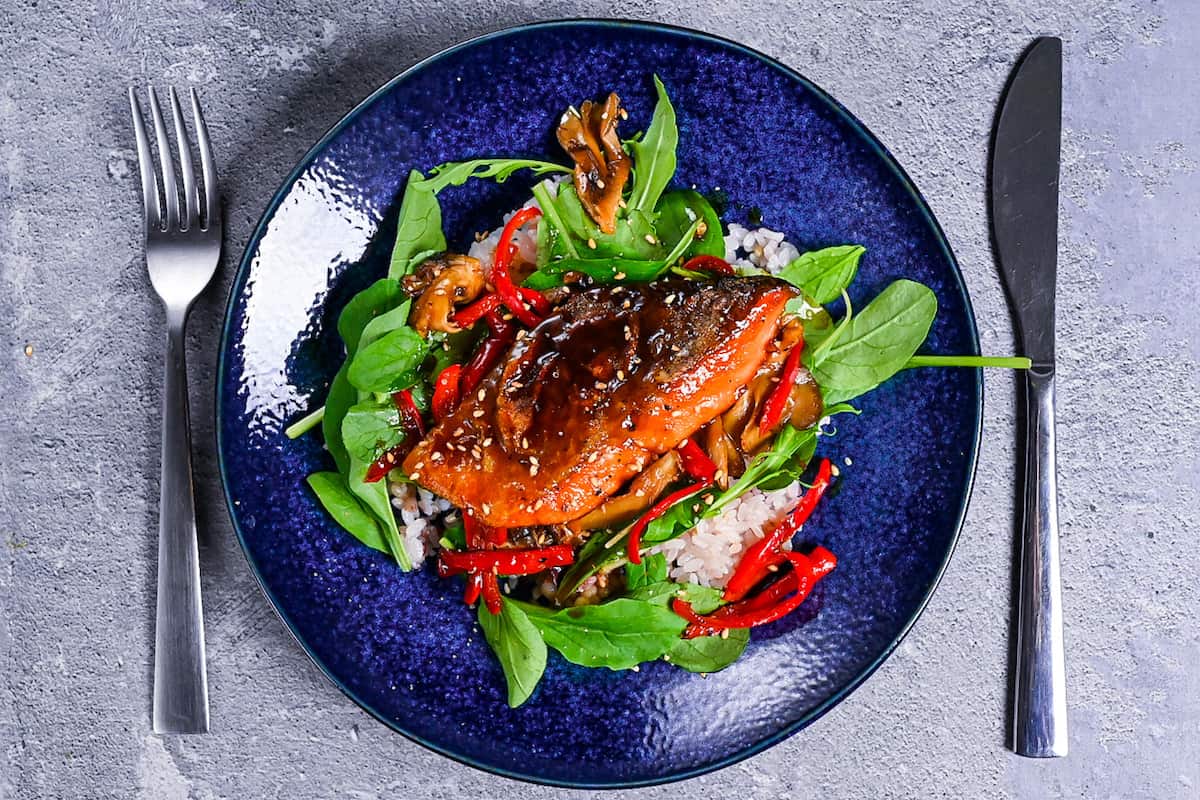

How I Developed This Recipe
When I was putting this recipe together for ponzu salmon, I wanted to create a dish that could be enjoyed as a one-plate meal, perfect for lunch or other occasions.
I wanted to highlight the sour taste of ponzu by creating a distinctive glaze that sets it apart from teriyaki.
This recipe is really straightforward to make, and I hope you’ll give it a try for a weekend lunch!

Ingredients & Substitution Ideas
- Ponzu Sauce: You can either use store-bought ponzu or make your own at home. I’ve done both, and each has its charm.
- Sake: If you don’t have sake, don’t worry. White wine or dry sherry are great substitutes.
- Mirin: To get that authentic Japanese flavor, I always use Hon Mirin.
- Salmon Fillets: I prefer using skin-on fillets to achieve a crispy finish. It really makes a difference in the texture.
- Potato Starch: If you don’t have potato starch, cornstarch or tapioca starch can be used instead. I’ve tried all three, and they all thicken sauces nicely.
- Unsalted Butter: It’s important to use unsalted butter to control the saltiness of the dish. If you only have salted butter, just reduce the amount of other salty ingredients.
- Vegetables: For this recipe, bell pepper, maitake mushrooms, or any mushrooms of your choice, and baby leaf salad work well. Feel free to choose based on what’s available or your preference.
- Cooked Japanese Short-Grain Rice: If you need tips on which brands are good in the U.S. or how to cook it in a pot, check out the How to Cook Japanese Rice Recipe.
- Sesame Seeds: These are an optional topping.
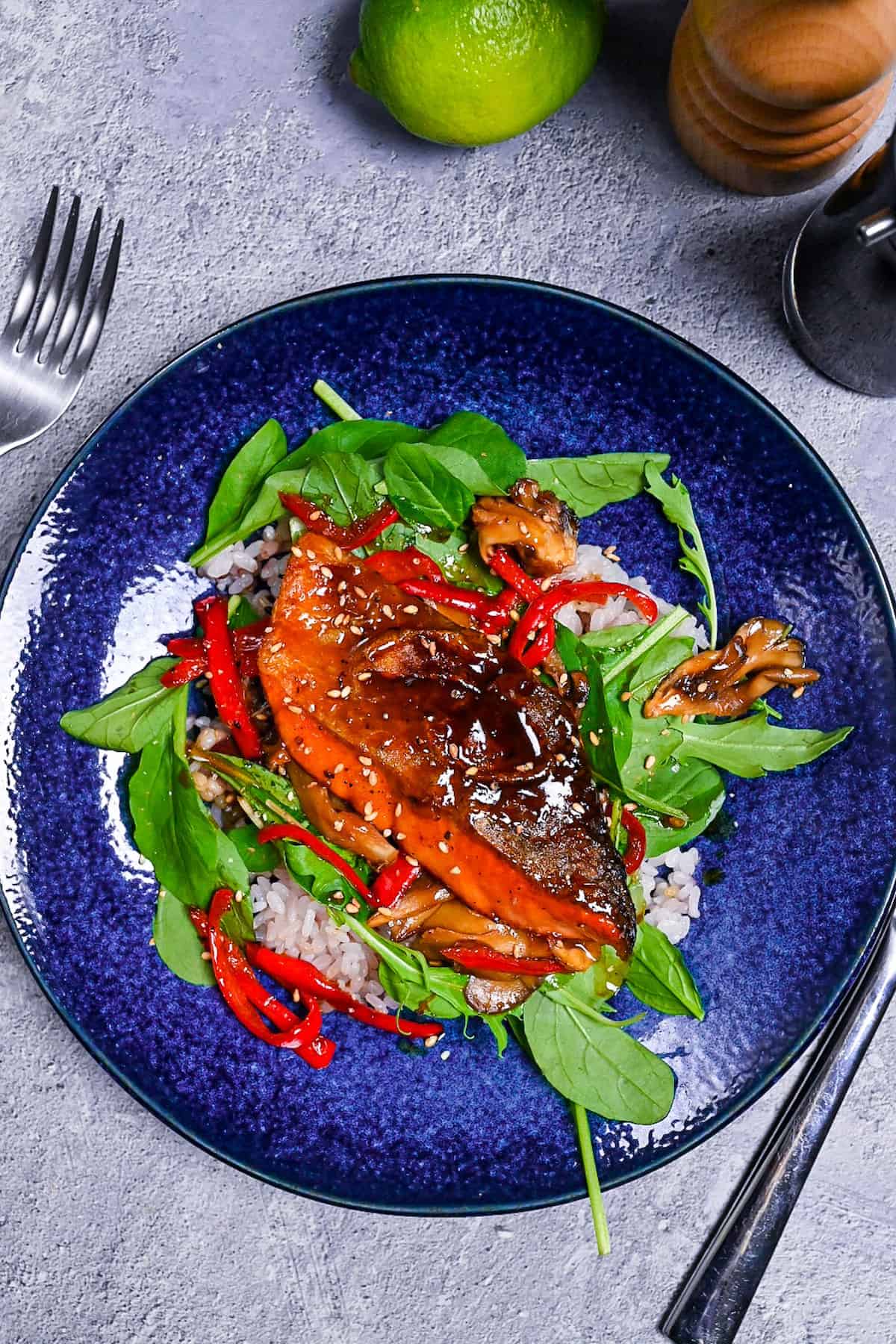
Visual Walkthrough & Tips
Here are my step-by-step instructions for how to make Ponzu Salmon at home. For ingredient quantities and simplified instructions, scroll down for the Printable Recipe Card below.
Start by mixing the ponzu, mirin and sake in a small bowl and set by the stove ready for later.
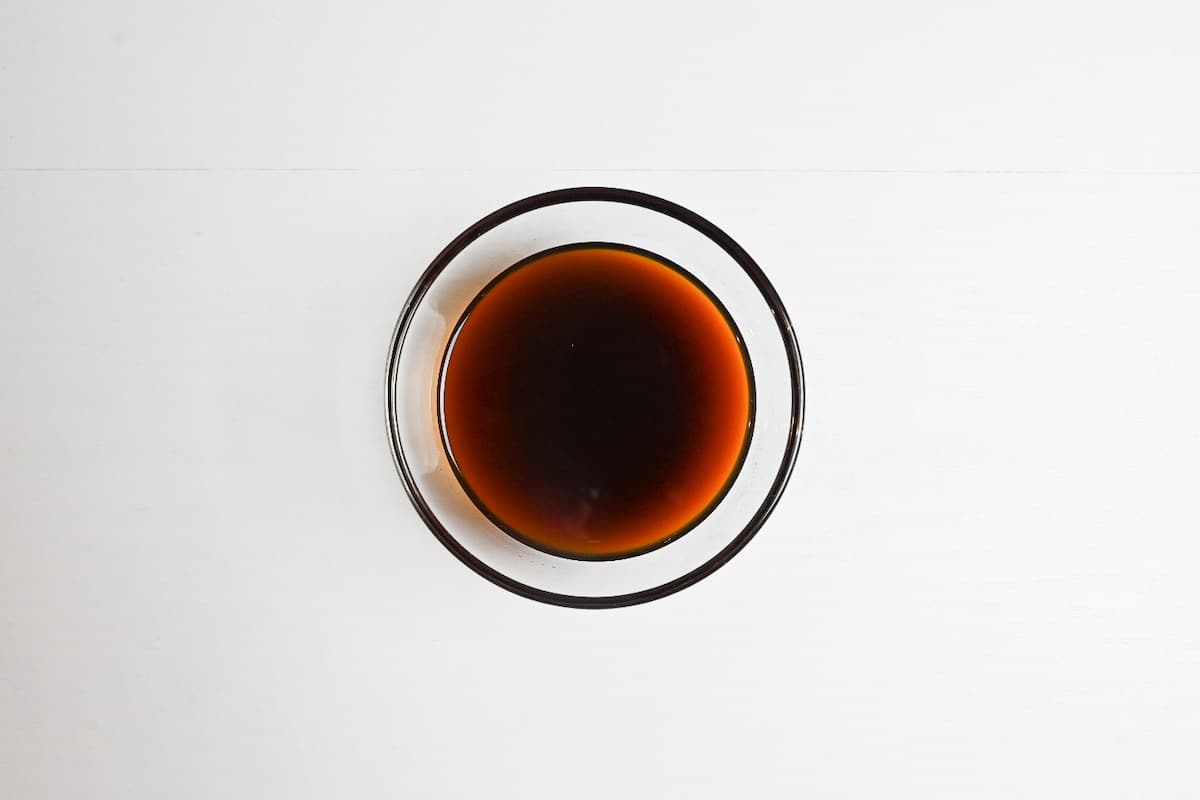
Pat the salmon dry on both sides using kitchen paper. This will remove the excess moisture and improve the taste of the salmon. It will also help the skin crisp up better when frying.
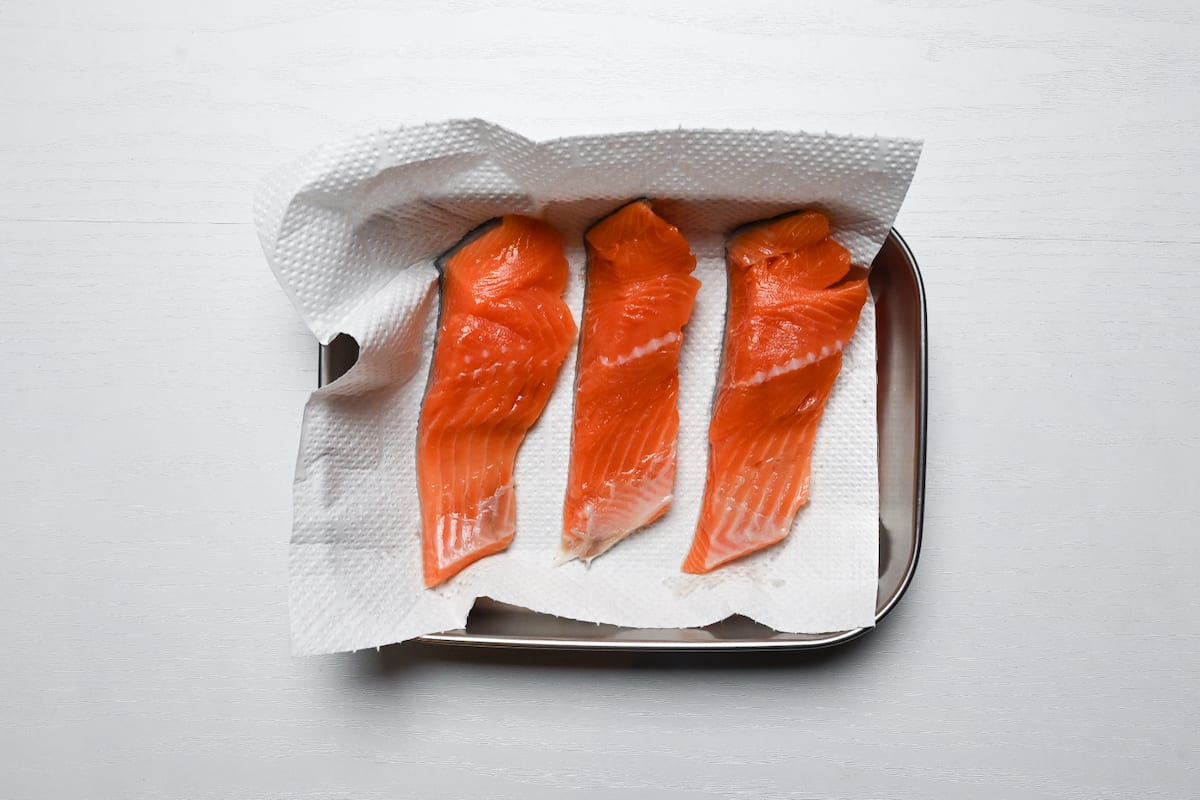
Sprinkle both sides with a pinch of salt and pepper, then coat with potato starch. The potato starch not only makes an extra crispy layer on the skin, but it also helps the sauce thicken and stick better to the surface of the salmon.

Next, heat a pan on medium and melt the butter. Swirl the butter around the pan so it’s evenly coated and place the salmon in with the skin side facing down. Fry on the skin side for about 4 minutes.
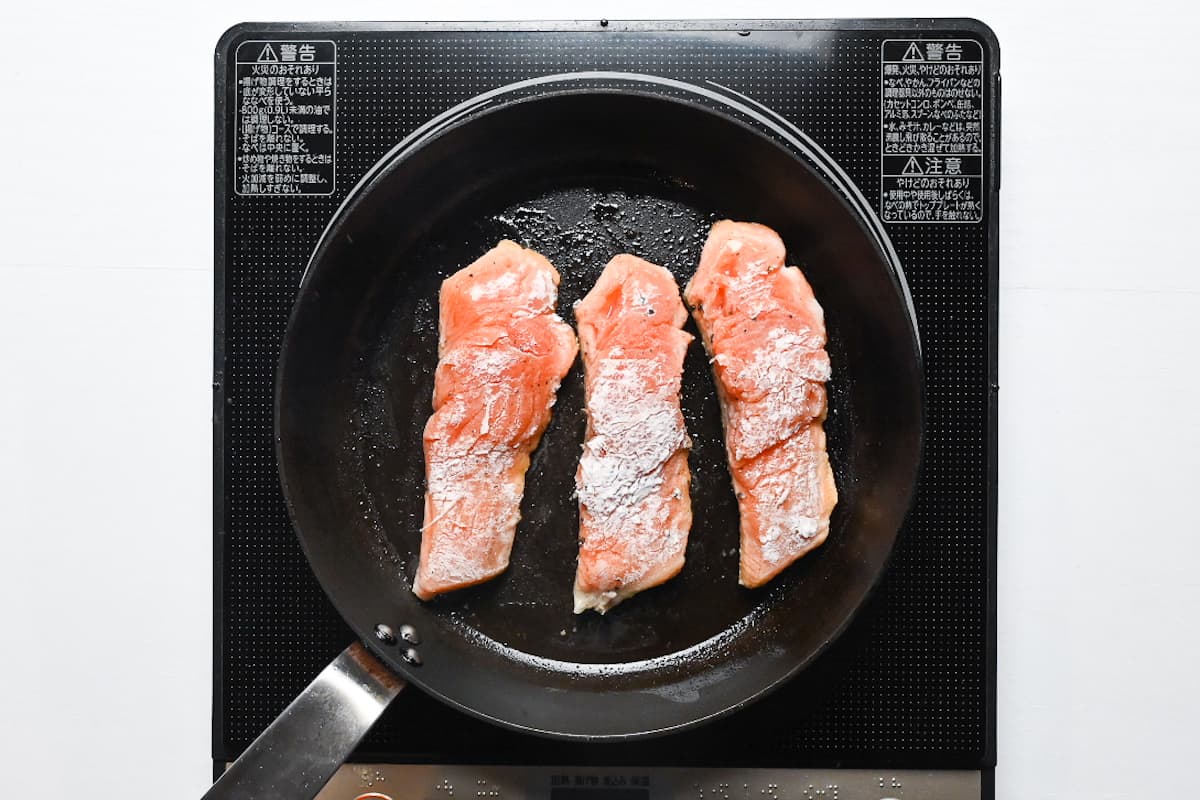
Flip the salmon and fry on the other side for 2 minutes or until cooked through. (Extra thick salmon fillets may need a little longer.)
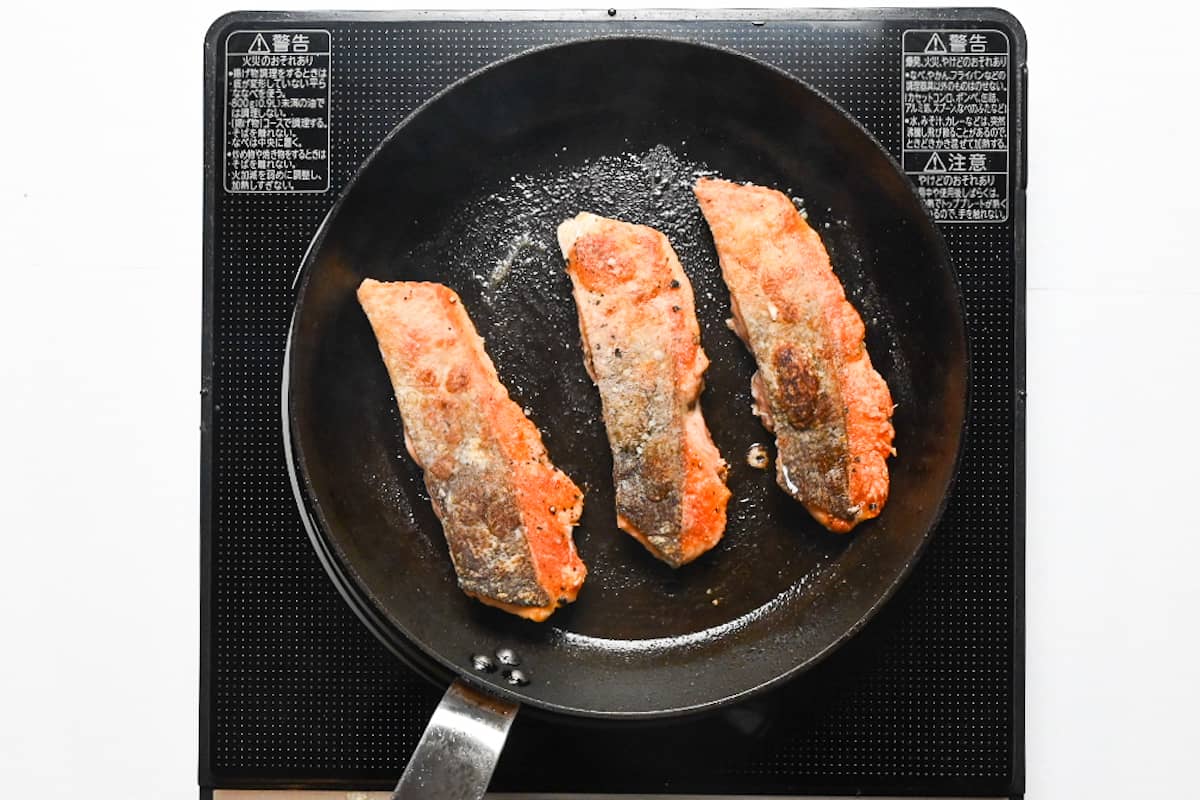
Once they’re cooked, remove them from the pan and set aside on a plate.
In the same pan, add sliced bell peppers and maitake mushrooms. Stir fry until the bell pepper is slightly softened. If you find the vegetables are sticking to the pan you can add a little more butter.

I cook the vegetables separately so that the salmon doesn’t become overcooked.
Push the vegetables to one side and place the salmon fillets back in the pan with the skin side facing up. Pour the sauce around the pan and baste the salmon fillets to ensure the top catches the flavors of the sauce. Do this continuously until the sauce has thickened slightly.
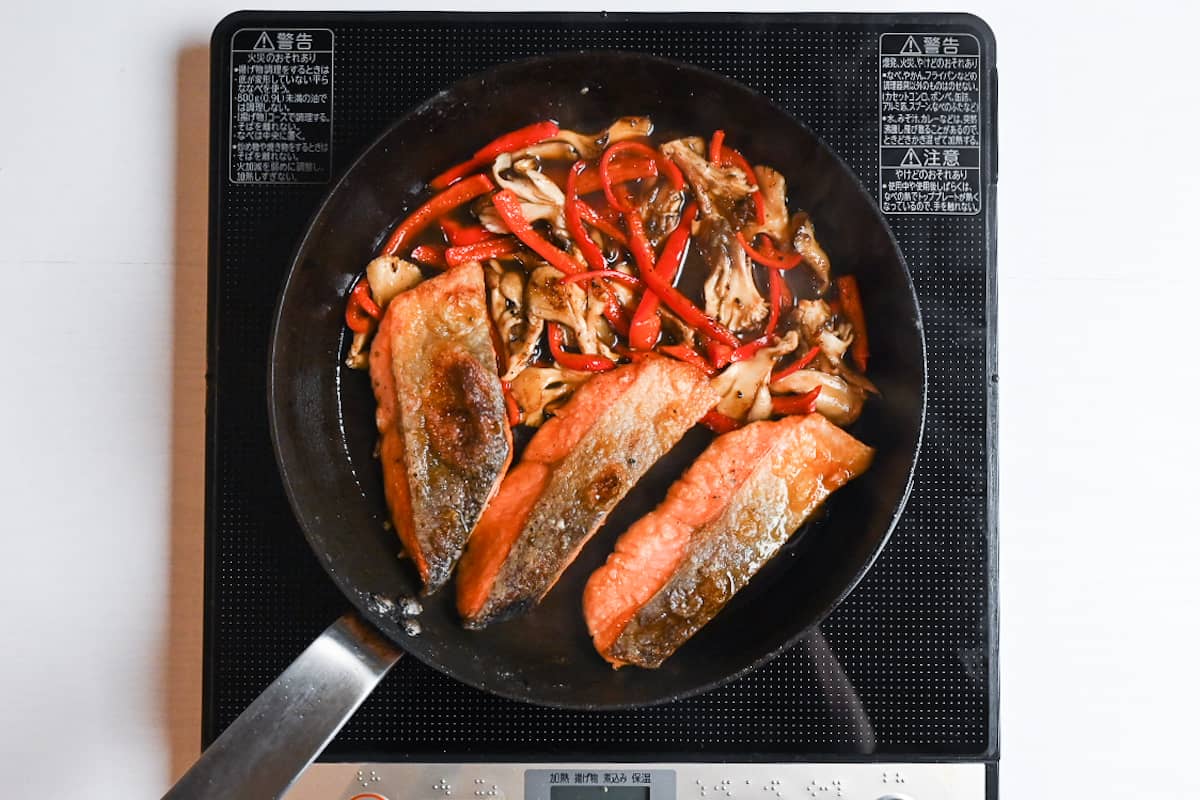
Avoid flipping the salmon during this last step as it is more likely to break.
Once the sauce has thickened, remove the pan from the heat.
Take your serving places and make a bed of rice.
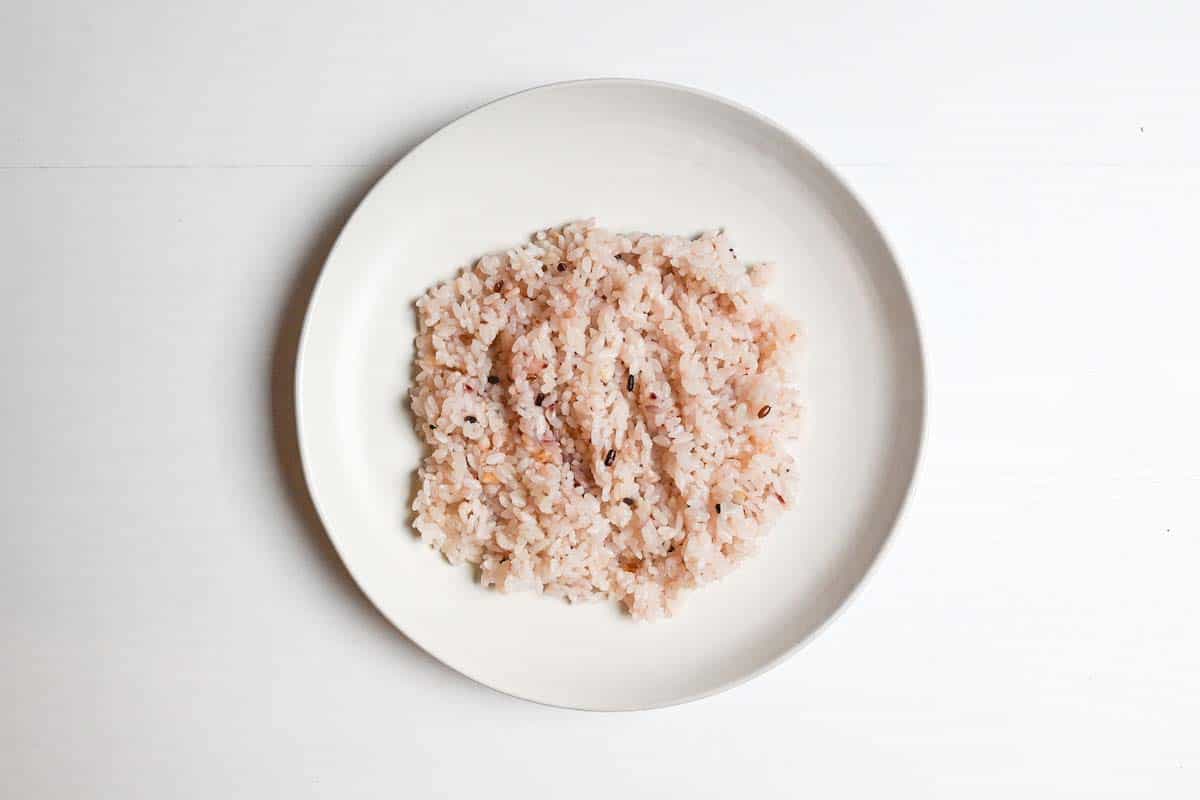
Top the rice with baby leaf or greens of your choice.
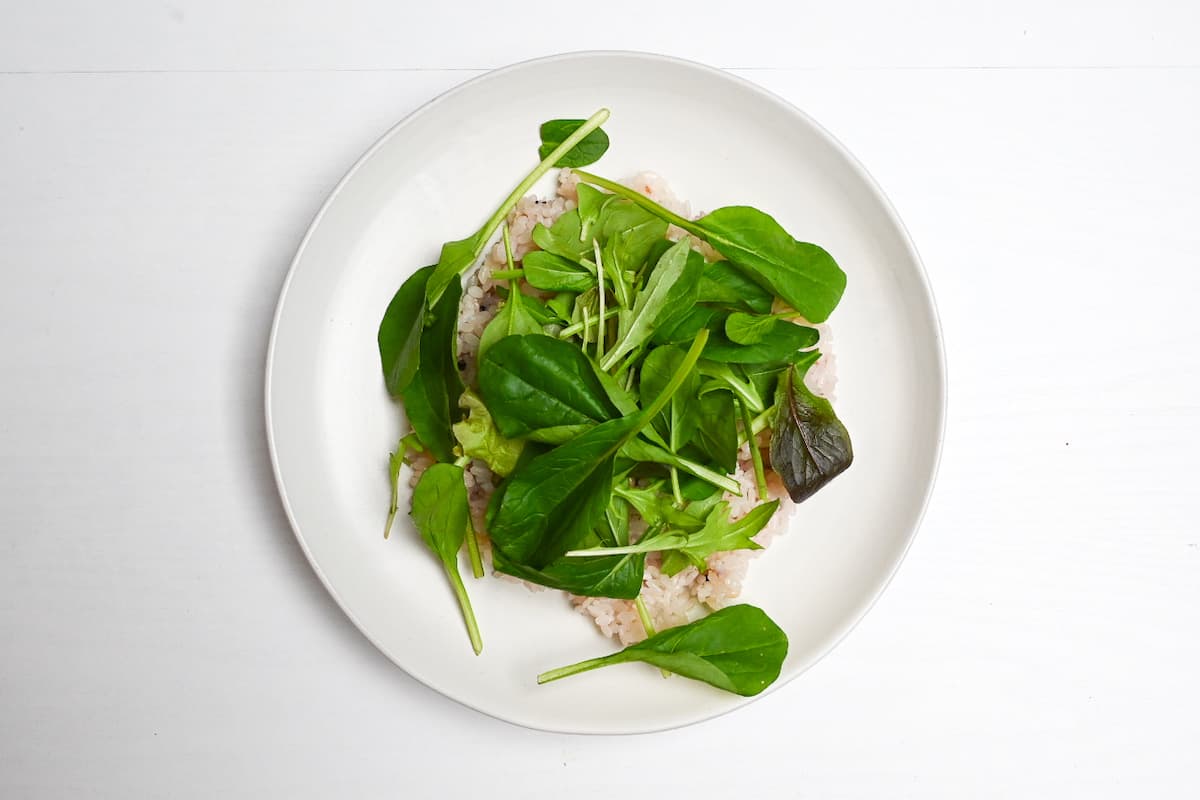
Next, add the sautéed vegetables.

Finally, place the salmon fillets (1-2 per portion depending on your appetite!) and pour any leftover sauce over the top.
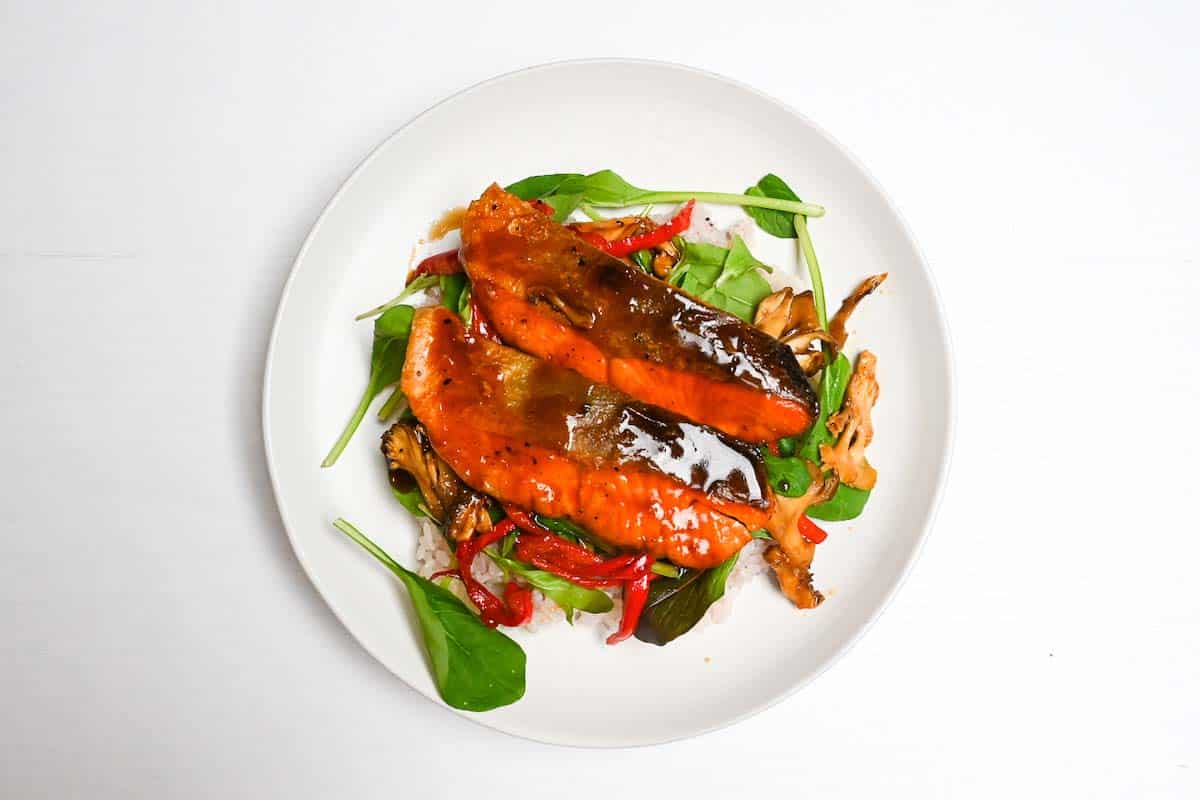
Enjoy!
Jump to Full Recipe Measurements
FAQ
Ponzu is a Japanese condiment made with a blend of citrus juice, vinegar, and soy sauce. The name “ponzu” is derived from the Dutch word “pons,” which refers to a type of citrus juice. Vinegar (“su” or “zu” in Japanese) was added to the juice, and Japanese “ponzu” was born.
Many different types of citrus are used to make ponzu, with some of the most popular options being yuzu (yuzupon), lemon, lime, kabosu, and bitter orange.
In Japan, ponzu is considered an “all-purpose condiment” and is commonly used as a dipping sauce, cooking ingredient, or marinade. The refreshing citrus punch makes it the perfect accompaniment for strong fish, fatty meats, and deep-fried dishes, as it helps to balance the flavor. In general, it’s a really great condiment to have in your kitchen!
If you’re interested, you can learn how to make your own ponzu from scratch using your favorite citrus fruits with my homemade ponzu recipe here! For store-bought ponzu, I recommend Mizkan’s “Ajipon,” which should be available in well-stocked Asian supermarkets. Alternatively, Kikkoman brand ponzu is available on Amazon.
I hope you enjoy this Ponzu Salmon recipe! If you try it out, I’d really appreciate it if you could spare a moment to let me know what you thought by giving a review and star rating in the comments below. It’s also helpful to share any adjustments you made to the recipe with our other readers. Thank you!
More Japanese Salmon Recipes

Ponzu Salmon (Pan Fried)
Ingredients
- 4 tbsp ponzu sauce
- 1 tbsp sake
- 1 tbsp mirin
- 2-3 salmon fillets
- 1 pinch salt and pepper
- 1 tbsp potato starch (katakuriko)
- 1 tbsp butter
- 30 g bell pepper sliced
- 50 g maitake mushrooms or mushroom of your choice, sliced
- 50 g baby leaf salad
- 300 g cooked multigrain rice 2 portions
- 1 tsp toasted white sesame seeds optional
My recommended brands of ingredients and seasonings can be found in my Japanese pantry guide.
Can’t find certain Japanese ingredients? See my substitution guide here.
Instructions
- Mix 4 tbsp ponzu sauce, 1 tbsp mirin and 1 tbsp sake in a bowl and set by the stove ready for later.

- Pat 2-3 salmon fillets dry with kitchen paper and sprinkle both sides with 1 pinch salt and pepper.

- Coat the salmon with a thin, even layer of 1 tbsp potato starch (katakuriko).

- Heat a pan on medium and melt 1 tbsp butter. Swirl the pan around and place the salmon fillets in with the skin-side facing down. Fry for 4 minutes or until the skin is crispy and golden.

- Flip and fry on the other side for 2 minutes. (Add an extra 1-2 minutes if your salmon fillets are especially thick.) Remove the salmon from the pan and set aside.

- In the same pan, add 30 g bell pepper and 50 g maitake mushrooms. (Add a little more butter if necessary.) Sauté until the bell peppers are slightly softened.

- Once softened, push the bell peppers and mushrooms to one side of the pan and place the salmon back in the pan with the skin side facing up. Pour the ponzu sauce around the pan and occasionally baste the top of the salmon. Once the sauce becomes glossy and slightly thickened, remove from the heat.

- Plate up 300 g cooked multigrain rice and place 50 g baby leaf salad on top. Add the sautéed vegetables and then the salmon.

- Drizzle any sauce leftover in the pan over the salmon and sprinkle with 1 tsp toasted white sesame seeds for a finishing touch.

- Enjoy!

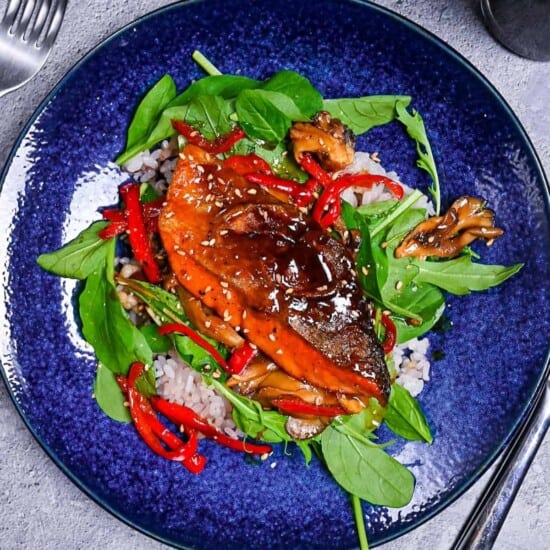


Delicious and easy! All of your recipes are tasty
Hi Luisa,
Thank you so much for your comment! I’m glad you’ve enjoyed my recipes! 🙂
Yuto
A big thank you, Yuto, for this new salmon recipe, which looks (almost ) just as delicious as it is original. I truly appreciate the care you put into sharing your culinary creations. A wonderful discovery that I can’t wait to make again and enjoy once more!
Hi Jean-Marie,
Thank you for such a lovely comment and your picture! It’s wonderful to hear that you enjoyed it so much you’re planning to make it again! Comments like this really make my day and inspire me to keep sharing recipes.
Yuto